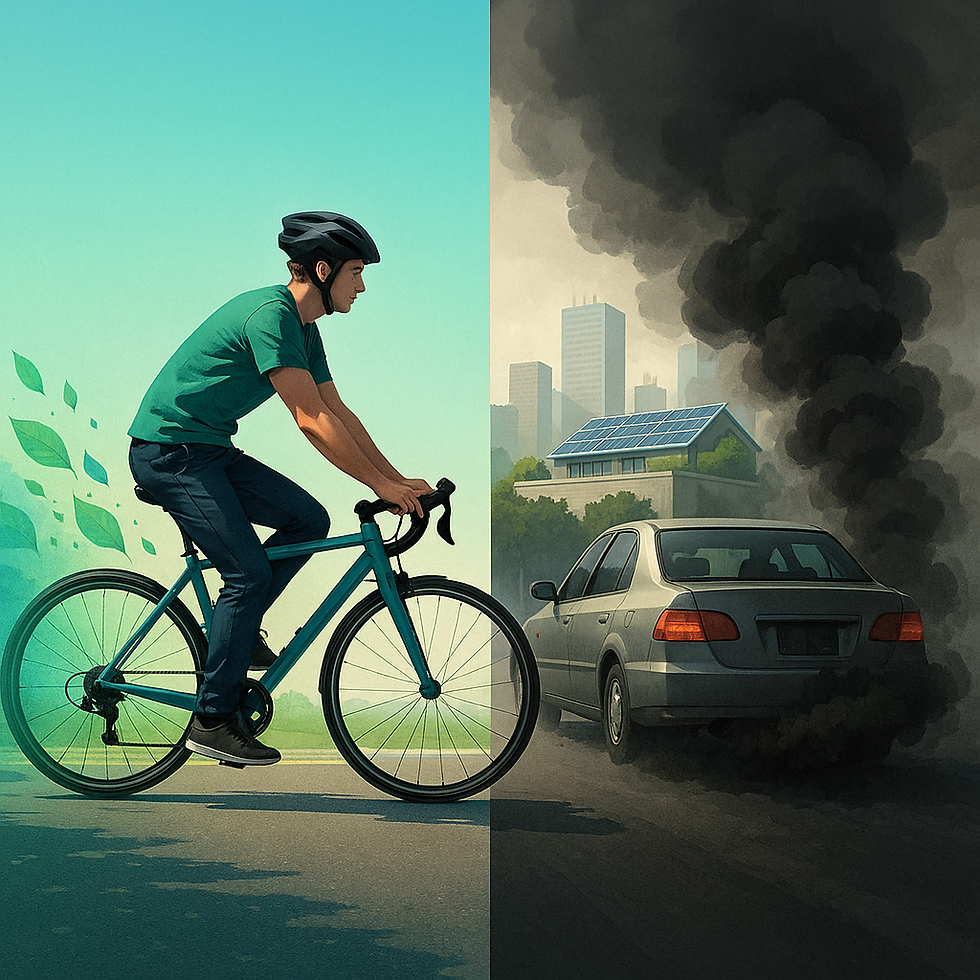Pedal Power or Sun Power? A Fun Carbon Check
- Akshay D
- Aug 2
- 6 min read
Ever wonder how much CO₂ you’re dumping into the air just by driving around? Let’s do something a little silly: compare hopping on your bike for 20 km a day with putting solar panels on your roof that cover 80 % of your home’s electricity. Neither is really “better”—it’s like comparing apples and oranges—but it’s a fun way to see how much carbon you can kick to the curb, whether it’s with sweat or sunshine. No fancy math degree needed—just a bit of curiosity and maybe a watermelon analogy or two.

1. Why This Carbon Showdown?
Alright, picture this: every time you fire up your car, you’re basically sending tiny packets of CO₂ into the air—kind of like handing out free party favors to pollution. Now imagine two goofy ways to crash that party. Option A: you ditch the car and hop on your bike for 20 km a day, trading engine fumes for leg power. Option B: you slap solar panels on your roof to cover 80 % of your home’s electricity, turning sunshine into sweet, clean juice.
Why bother comparing these two? Honestly, it’s a bit like asking which is more fun—juggling watermelons or juggling Wi-Fi routers. Neither one’s a perfect solution, but both kick carbon gremlins to the curb in their own way. Plus, breaking down the numbers side by side gives you a neat snapshot of how small changes in your daily routine—or your rooftop—can add up to something surprisingly big.
Think of this section as the referee’s whistle: we’re setting the stage, laying out the contenders, and reminding you that the real winner here is a healthier planet (and maybe a few less watermelon pounds of CO₂). So let’s get to the meat of it—or, well, the rind of it—and see how sweat and sunshine measure up.
2. Sweat vs. Sunshine: Assumptions & CO₂ Numbers
Before we dive in, here’s what we’re assuming—nothing fancy, just enough to keep our math grounded:
Car emissions: 180 g CO₂/km (typical for a petrol hatchback)
Daily ride: 20 km every day, no slacking off
Home use: 3,000 kWh/year from the grid (lights, fridge, fans, etc.)
Solar coverage: Panels supply 80% → 2,400 kWh clean power per year
Grid carbon factor: 0.8 kg CO₂ avoided per kWh not drawn from the grid
Panel size: Roughly a 3 kW array (20–25 m² of panels) to hit 2,400 kWh/year
Year length: 365 days, so daily figures × 365 = yearly totals
A. Pedal Power: CO₂ Saved by Cycling
Daily save: 20 km × 180 g = 3.6 kg CO₂
Monthly (30 days): 3.6 kg × 30 ≈ 108 kg CO₂
Yearly (365 days): 3.6 kg × 365 ≈ 1,314 kg CO₂ (~1.3 tonnes)
Fun fact: That’s like not burning about 570 L of petrol in a year.
B. Sun Power: CO₂ Saved by Solar
Annual clean juice: 2,400 kWh from your rooftop
CO₂ offset: 2,400 kWh × 0.8 kg = 1,920 kg CO₂ (~1.9 tonnes)
Quick context: A 3 kW system covering 20–25 m² will generally deliver this in sunny regions.
What You Do | CO₂ Saved per Year | CO₂ Saved per Month | Petrol Litre Equivalent (≈) |
Cycle 20 km/day | 1,314 kg | ~110 kg | ~48 L |
80% Solar | 1,920 kg | ~160 kg | ~70 L |
Quick take: Solar panels edge out the bike by about 600 kg CO₂ per year—but both give you solid bragging rights (and a fun story next time someone asks you to “do your bit” for the planet).
3. Perks Beyond Pollution
Okay, now that we’ve geeked out on CO₂ stats, let’s talk about the non-carbon perks. Because hey, saving the planet is awesome, but what else do you get? Spoiler: quite a lot.
A. Bike Gains
Free Gym Membership
No more pricey fitness plan: your 20 km commute doubles as cardio and strength training.
Bonus: sculpted calves and quads that even Instagram can’t ignore.
Money in Your Pocket
Zero fuel costs. At ₹100/L, skipping 570 L of petrol a year saves you ~₹57,000!
Minimal maintenance: a puncture kit and chain lube beat costly servicing bills.
Stress-Busting Commute
Fresh air > traffic jams. Science shows cycling releases endorphins that melt away stress.
Goodbye road rage, hello morning sunshine and birdsong (and maybe the occasional friendly nod from another cyclist).
Community & Cool Points
Join local cycling groups or weekend rides—instant new friends who share your love of two wheels.
You get the nod of respect from fellow eco-warriors whenever you roll up.
Urban Ninja Moves
Zip past gridlock, find easy parking, and explore hidden city lanes you’d never see by car.
More time for coffee stops and street-side samosas—win-win for your mood and your taste buds.
B. Solar Wins
Slash Your Electricity Bill
Covering 80% of a 3,000 kWh/year load can cut your bill by ₹12,000–₹18,000 annually (depending on your tariff).
Inflation-proof energy: sunshine doesn’t charge surge prices.
Boost Your Home’s Value
Studies show homes with rooftop solar sell faster and at a premium—talk about a smart investment.
It’s like a high-tech facelift: instant curb appeal for buyers who care about “green homes.”
Low-Maintenance & Long-Lasting
After installation, panels require little more than an annual clean and occasional check-up.
Most systems come with 25-year warranties—peace of mind for decades.
Government Incentives & Net Metering
Subsidies, accelerated depreciation, or zero-interest loans can drop your upfront costs.
Excess power you export can earn you credits on your bill—basically getting paid to soak up the sun.
Energy Independence & Security
Less reliance on the grid means fewer shocks during power cuts.
You become your own mini utility, immune to sudden tariff hikes.
Green-Bragging Rights
Telling friends “my roof is basically a photon factory” never gets old.
You become the go-to solar guru in your social circle—instant expert status.
By now, you’ve got the carbon-saving skinny and the bonus perks for both cycling and solar. Whether you’re after toned thighs or a lighter bill, each option brings its own brand of feel-good vibes. Next up: which of these two carbon-crushing champs is more your style? Stay tuned for the final verdict!

5. Next Steps & DIY Carbon Calculator
Ready to turn this fun CO₂ face-off into your own personal experiment? Here’s how you can take action—and build a super-simple calculator to see your real savings.
A. Take Action Today
Try a “No-Car Day”
Pick one weekday (or weekend) and swap four wheels for two.
Note how many kilometres you ride and how you feel—more energy? fresher air? share on social media with #CarbonCarnival.
Get a Solar Quote
Use a local installer’s online tool (many sites let you enter your roof area and get a rough price).
Check for government subsidies or low-interest loans in your area to cut the upfront cost.
Join a Community
Find a cycling club or solar homeowners’ group on Facebook or WhatsApp.
Sharing tips and war stories makes both bike rides and panel installations more fun—and more likely to stick.
B. Build Your Own CO₂ Calculator in Google Sheets
Create a New Sheet
Open Google Sheets and title it “My CO₂ Calculator.”
Set Up Input Cells
CellLabelExample ValueNotesA1Car Emission (g/km)180Change for your car’s specA2Daily Bike Distance (km)20Your commute or average rideA3Household Use (kWh/year)3000Check your last electricity billA4Solar Coverage (%)80Panels’ share of your home’s consumptionA5Grid CO₂ Factor (kg/kWh)0.8Look up your region’s emission factor
Add Calculation Formulas
Daily Bike Saving (kg):
= (A1/1000) * A2
Annual Bike Saving (kg):
= ((A1/1000) A2) 365
Annual Solar Saving (kg):
= (A3 (A4/100)) A5
Total CO₂ Saved (kg):
= (Annual Bike Saving) + (Annual Solar Saving)
Make It Yours
Change A1–A5 to match your car, commute, home size, panel layout, or local grid factor.
Add a chart (Insert → Chart) to visualize bike vs. solar vs. combined savings.
Bonus Features
“What If” Scenarios: Duplicate the sheet and tweak your daily km or solar % to see different outcomes.
Cost Savings: Multiply your annual CO₂ saved by your local petrol price ÷ (car’s km per litre) to convert to rupees saved on fuel.
Peer Challenge: Share the sheet with friends and compare who’s the biggest carbon bouncer.
With this little DIY tool, you’ll have your own hands-on carbon showdown—far more accurate (and fun) than any back-of-the-envelope watermelon analogy. Now go forth, tweak those numbers, and brag about your personalised CO₂ coup!

At the end of the day, whether you’re burning calories on a 20 km ride or soaking up sunshine on your rooftop, you’re kicking CO₂ to the curb—and that’s something to brag about. Pick the option that sparks joy (or do both!), tweak your own numbers in the calculator, and celebrate every kilo of carbon you keep out of the air. Here’s to cleaner commutes, brighter homes, and a planet that’s just a little happier because of you.






Comments